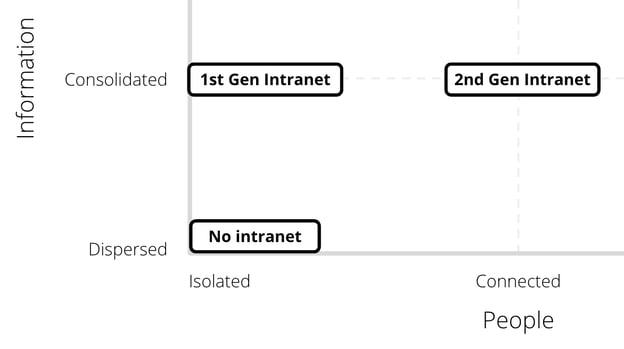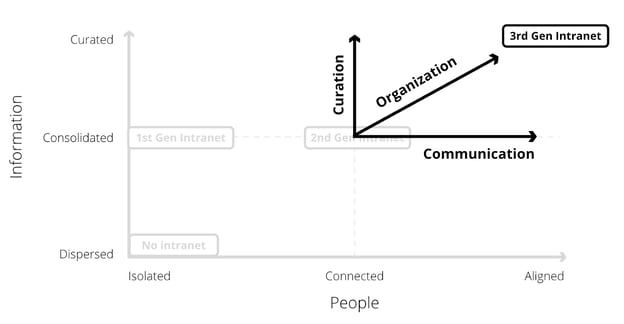By Brad Palmer
4 min read

Most of us have experienced an employee intranet that’s like a “ghost town”—a place full of old stuff that no one visits. Yet, in our new work-from-home world, intranets have become mission critical. It’s not just the world that changed; intranets have too. Let’s dig in and explore how intranets have evolved to solve the workplace challenges we now face.
In the beginning, employee intranets were simply places to share internal documents. That’s where Microsoft SharePoint began many decades ago. Not very engaging, but when you needed to find the current copy of a policy, essential.
And with that, the first intranet challenge arrived in spades—intranets became “the place documents go to die”, such that they were cluttered with outdated information. This relentless arrival of new information remains a key challenge for every intranet.
True to its name, early intranets were functioning as “internal websites”. All the first-generation intranet platforms were website building tools. Guess what? Most intranet platforms today still use this page-building approach.
But by creating a new page for every new topic and initiative compounds the problem of intranet bloat. New pages pile on old ones, so it quickly becomes difficult to find what you need, or know what is relevant.
This problem of page proliferation cannot be understated. Philips provides an example of how big this challenge can be for larger companies, “We slimmed down our intranet from more than 123,000 pages to fewer than 5,000.” reports Dennis Agusi, Director of Communication Channels. Even smaller companies normally see their page counts swell into the hundreds.
Then, in the late 2000’s, “Enterprise Social Networking” became a fad that every VC had a bet on. The concept here was “Facebook for the enterprise”. All these ventures failed. Partly because people are intensely busy at work; when they come to their intranet, they look for something specific and don’t have time to be social for social’s sake.
Facebook is designed to entertain and maximize your time on site. That’s not the right measure of success for an intranet. A great intranet will see frequent visits, but each visit will be short and purposeful.
Although intranets are not about entertainment, they are certainly about people. And that became the next focus of intranet development. When you are looking for help at work, it is often a person you are looking for, not a document or policy.

This chart plots the two key “axes” of employee intranets--information and people. 1st generation intranets focused on gathering key documents; 2nd generation intranets added the ability to find and connect with people.
So let’s recap where we're at:
What's next?
In today’s world, intranets need to be so much more than just this. Even before the surge in work-from-home, companies were already dispersed across many locations and timezones. That’s when your intranet becomes the place where your culture lives.
In fact, your intranet is the most tangible embodiment of who you are as an organization. It’s where stories are shared, values are lived, and communication happens. Our COVID-impacted world has helped us all understand the impact of a connected workplace culture.
Modern intranets must double down on communication. They need to provide a single place for internal communication to happen, effectively eliminating the clutter of internal emails.
It’s important to recognize that communication must happen up, down, and across organizations. A great intranet provides everything from a private 1:1 chat, to the formal rollout and sign-off of a new policy. Both top-down and bottom-up communication are essential. Done well, it becomes possible to work in an open, transparent way, without creating undue “noise” across the enterprise.
However, providing the necessary set of communication tools is not enough. Modern intranets also need to deal with the relentless onslaught of information. New content arrives daily, piling onto what is already there. Intranets must effectively deal with this through a combination of curation and organization.
The foundation of effective curation lies in clear ownership of content. When a subject matter expert has clear ownership of the information they provide, and a simple toolset to manage it, curation becomes much easier.
Organization is about providing ways for people to navigate to what they are looking for. Effective universal search is also essential, but being able to understand how information is organized is critical.
Organization is not just about files. It’s also about people. Understanding who is doing what, who is on which project team, who is at which location, helps people find the help they need and coordinate their work with others.
Organizing people in a way that you can dynamically target information is mission critical. Being able to target a safety notice to just “Engineers in Canada” who are in the “Mobile Business Unit” means that your salespeople are not distracted, and your US engineers are not confused. It also means that when a new engineer is hired in Canada next week, they automatically see this important notice and are prompted to welcome them. Targeting like this means that each employee only sees the content that is relevant to them—an important weapon in the endless fight against clutter.
It’s the effective implementation of curation, organization, and communication that are bringing us the 3rd generation intranets:

Such intranets truly enable each employee. And with that, magic happens. Teams align, your culture thrives, and the potential of each and every employee is unleashed.
One thing we must say: to enable each and every employee, your intranet cannot just live at the desk of your knowledge workers. It needs to be equally effective on everyone’s phone. In break rooms and factory floors alike. It’s only then that everyone in your organization can be plugged in and connected, be they at home, on the field, or at the office.
Read more by
Brad Palmer
Jostle’s employee success platform is where everyone connects, communicates, and celebrates at work. Find out more at jostle.me. © 2009–2025 Jostle Corporation. All rights reserved.